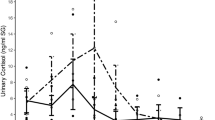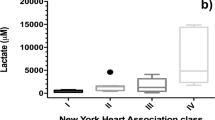Abstract
Making a definite diagnosis of Cushing's syndrome is a challenging problem. Unsuspected Cushing's syndrome occurs in 2–3% of patients with poorly controlled diabetes, 0.5–1% with hypertension, 6–9% with incidental adrenal masses, and 11% with unexplained osteoporosis and vertebral fractures. The increasing recognition of this syndrome highlights the need for a simple, sensitive, and specific diagnostic test. Patients with Cushing's syndrome consistently do not reach a normal nadir of cortisol secretion at night. The measurement of late-night salivary cortisol levels might, therefore, provide a new diagnostic approach for this disorder. Salivary cortisol concentrations reflect those of active free cortisol in plasma and saliva samples can easily be obtained in a nonstressful environment (e.g. at home). Late-night salivary cortisol measurement yields excellent overall diagnostic accuracy for Cushing's syndrome, with a sensitivity of 92–100% and a specificity of 93–100%. Several factors can, however, make interpretation of results difficult; these factors include disturbed sleep–wake cycles, contamination of samples (particularly by topical corticosteroids), and illnesses known to cause physiologic activation of the pituitary–adrenal axis. In this Review, we discuss the methods and value of measuring salivary cortisol for the diagnosis of Cushing's syndrome, and put forward some recommendations to maximize accuracy of results.
Key Points
-
Cushing's syndrome is an endocrinopathy with serious complications and high associated mortality
-
The prevalence of Cushing's syndrome is higher than previously appreciated, particularly in high-risk patient populations (e.g. individuals with diabetes, osteoporosis, and incidental adrenal masses)
-
Late-night salivary cortisol testing can identify failure to achieve a normal circadian nadir and may, therefore, be used in the diagnosis of Cushing's syndrome
-
Late-night salivary cortisol has sensitivity of 92–100% and specificity of 93–100% for the diagnosis of Cushing's syndrome
-
Several factors should be kept in mind when interpreting late-night salivary cortisol results (e.g. abnormal sleep–wake cycle, acute stress, and contamination with topical steroids)
This is a preview of subscription content, access via your institution
Access options
Subscribe to this journal
Receive 12 print issues and online access
$209.00 per year
only $17.42 per issue
Buy this article
- Purchase on Springer Link
- Instant access to full article PDF
Prices may be subject to local taxes which are calculated during checkout

Similar content being viewed by others
References
Aron DC (2005) Cushing's syndrome from bedside to bench and back: a historical perspective. Endocrinol Metab Clin North Am 34: 257–269, vii
Findling JW and Raff H (2006) Cushing's Syndrome: important issues in diagnosis and management. J Clin Endocrinol Metab 91: 3746–3753
Findling JW and Raff H (2001) Diagnosis and differential diagnosis of Cushing's syndrome. Endocrinol Metab Clin North Am 30: 729–747
Newell-Price J et al. (2006) Cushing's syndrome. Lancet 367: 1605–1617
Lindholm J et al. (2001) Incidence and late prognosis of Cushing's syndrome: a population-based study. J Clin Endocrinol Metab 86: 117–123
Anderson GH et al. (1994) The effect of age on prevalence of secondary forms of hypertension in 4429 consecutively referred patients. J Hypertens 12: 609–615
Omura M et al. (2004) Prospective study on the prevalence of secondary hypertension among hypertensive patients visiting a general outpatient clinic in Japan. Hypertens Res 27: 193–202
Catargi B et al. (2003) Occult Cushing's syndrome in type-2 diabetes. J Clin Endocrinol Metab 88: 5808–5813
Leibowitz G et al. (1996) Pre-clinical Cushing's syndrome: an unexpected frequent cause of poor glycaemic control in obese diabetic patients. Clin Endocrinol (Oxf) 44: 717–722
Reincke M et al. (1992) Preclinical Cushing's syndrome in adrenal “incidentalomas”: comparison with adrenal Cushing's syndrome. J Clin Endocrinol Metab 75: 826–832
Terzolo M et al. (2002) Adrenal incidentaloma: a new cause of the metabolic syndrome? J Clin Endocrinol Metab 87: 998–1003
Chiodini I et al. (2007) Subclinical hypercortisolism among outpatients referred for osteoporosis. Ann Intern Med 147: 541–548
Plotz CM et al. (1952) The natural history of Cushing's syndrome. Am J Med 13: 597–614
Swearingen B et al. (1999) Long-term mortality after transsphenoidal surgery for Cushing disease. Ann Intern Med 130: 821–824
Etxabe J and Vazquez JA (1994) Morbidity and mortality in Cushing's disease: an epidemiological approach. Clin Endocrinol (Oxf) 40: 479–484
Raff H and Findling JW (2003) A physiologic approach to diagnosis of the Cushing syndrome. Ann Intern Med 138: 980–991
Keller J et al. (2006) Cortisol circadian rhythm alterations in psychotic major depression. Biol Psychiatry 60: 275–281
Carroll T et al. (2007) Pathophysiology of hypercortisolism in depression. Acta Psychiatr Scand Suppl 433: 90–103
Letizia C et al. (1996) Effects of haemodialysis session on plasma beta-endorphin, ACTH and cortisol in patients with end-stage renal disease. Scand J Urol Nephrol 30: 399–402
Raff H et al. (1998) Late-night salivary cortisol as a screening test for Cushing's syndrome. J Clin Endocrinol Metab 83: 2681–2686
Doe RP et al. (1960) Diurnal variation of 17-hydroxycorticosteroids, sodium, potassium, magnesium and creatinine in normal subjects and in cases of treated adrenal insufficiency and Cushing's syndrome. J Clin Endocrinol Metab 20: 253–265
Glass AR et al. (1984) Circadian rhythm of serum cortisol in Cushing's disease. J Clin Endocrinol Metab 59: 161–165
Refetoff S et al. (1985) The effect of dexamethasone on the 24-hour profiles of adrenocorticotropin and cortisol in Cushing's syndrome. J Clin Endocrinol Metab 60: 527–535
Gorges R et al. (1999) Diagnosis of Cushing's syndrome: re-evaluation of midnight plasma cortisol vs urinary free cortisol and low-dose dexamethasone suppression test in a large patient group. J Endocrinol Invest 22: 241–249
Wood PJ et al. (1997) Evidence for the low dose dexamethasone suppression test to screen for Cushing's syndrome—recommendations for a protocol for biochemistry laboratories. Ann Clin Biochem 34: 222–229
Mengden T et al. (1992) Urinary free cortisol versus 17-hydroxycorticosteroids: a comparative study of their diagnostic value in Cushing's syndrome. Clin Investig 70: 545–548
Crapo L (1979) Cushing's syndrome: a review of diagnostic tests. Metabolism 28: 955–977
Carroll BJ et al. (1976) Urinary free cortisol excretion in depression. Psychol Med 6: 43–50
Invitti C et al. (1991) Increased urinary free cortisol and decreased serum corticosteroid-binding globulin in polycystic ovary syndrome. Acta Endocrinol (Copenh) 125: 28–32
Reimondo G et al. (2005) Evaluation of the effectiveness of midnight serum cortisol in the diagnostic procedures for Cushing's syndrome. Eur J Endocrinol 153: 803–809
Papanicolaou DA et al. (1998) A single midnight serum cortisol measurement distinguishes Cushing's syndrome from pseudo-Cushing states. J Clin Endocrinol Metab 83: 1163–1167
Newell-Price J et al. (1995) A single sleeping midnight cortisol has 100% sensitivity for the diagnosis of Cushing's syndrome. Clin Endocrinol (Oxf) 43: 545–550
Giraldi FP et al. (2007) Specificity of first-line tests for the diagnosis of Cushing's syndrome: assessment in a large series. J Clin Endocrinol Metab 92: 4123–4129
Katz FH and Shannon IL (1964) Identification and significance of parotid fluid corticosteroids. Acta Endocrinol (Copenh) 46: 393–404
Shannon IL et al. (1966) Dexamethasone suppression tests employing parotid fluid. J Clin Endocrinol Metab 26: 967–969
Bolufer P et al. (1989) Salivary corticosteroids in the study of adrenal function. Clin Chim Acta 183: 217–225
Kahn JP et al. (1988) Salivary cortisol: a practical method for evaluation of adrenal function. Bio Psychiatry 23: 335–349
Read GF et al. (1990) Steroid analysis in saliva for the assessment of endocrine function. Ann N Y Acad Sci 595: 260–274
Reid JD et al. (1992) The relationship of serum and salivary cortisol in a sample of healthy elderly. J Gerontol 47: 176–179
Luthold WW et al. (1985) Salivary cortisol for the evaluation of Cushing's syndrome. Clin Chim Acta 151: 33–39
Shirtcliff EA et al. (2001) Use of salivary biomarkers in biobehavioral research: cotton-based sample collection methods can interfere with salivary immunoassay results. Psychoneuroendocrinology 26: 165–173
Poll EM et al. (2007) Saliva collection method affects predictability of serum cortisol. Clin Chim Acta 382: 15–19
Clements AD and Parker CR (1998) The relationship between salivary cortisol concentrations in frozen versus mailed samples. Psychoneuroendocrinology 23: 613–616
Baid SK et al. (2007) Radioimmunoassay and tandem mass spectrometry measurement of bedtime salivary cortisol levels: a comparison of assays to establish hypercortisolism. J Clin Endocrinol Metab 92: 3102–3107
Hansen AM et al. (2003) Evaluation of a radioimmunoassay and establishment of a reference interval for salivary cortisol in healthy subjects in Denmark. Scand J Clin Lab Invest 63: 303–310
Raff H et al. (2003) New enzyme immunoassay for salivary cortisol. Clin Chem 49: 203–204
Yao JK et al. (1998) Determination of salivary cortisol by nonisotopic immunoassay. Clin Biochem 31: 187–190
Vogeser M et al. (2006) Measurement of late-night salivary cortisol with an automated immunoassay system. Clin Chem Lab Med 44: 1441–1445
Castro M et al. (1999) Out-patient screening for Cushing's syndrome: the sensitivity of the combination of circadian rhythm and overnight dexamethasone suppression salivary cortisol tests. J Clin Endocrinol Metab 84: 878–882
Gafni RI et al. (2000) Nighttime salivary cortisol measurement as a simple, noninvasive, outpatient screening test for Cushing's syndrome in children and adolescents. J Pediatr 137: 30–35
Laudat MH et al. (1988) Salivary cortisol measurement: a practical approach to assess pituitary-adrenal function. J Clin Endocrinol Metab 66: 343–348
Martinelli CE et al. (1999) Salivary cortisol for screening of Cushing's syndrome in children. Clin Endocrinol (Oxf) 51: 67–71
Papanicolaou DA et al. (2002) Nighttime salivary cortisol: a useful test for the diagnosis of Cushing's syndrome. J Clin Endocrinol Metab 87: 4515–4521
Putignano P et al. (2003) Midnight salivary cortisol versus urinary free and midnight serum cortisol as screening tests for Cushing's syndrome. J Clin Endocrinol Metab 88: 4153–4157
Trilck M et al. (2005) Salivary cortisol measurement—a reliable method for the diagnosis of Cushing's syndrome. Exp Clin Endocrinol Diabetes 113: 225–230
Viardot A et al. (2005) Reproducibility of nighttime salivary cortisol and its use in the diagnosis of hypercortisolism compared with urinary free cortisol and overnight dexamethasone suppression test. J Clin Endocrinol Metab 90: 5730–5736
Yaneva M et al. (2004) Midnight salivary cortisol for the initial diagnosis of Cushing's syndrome of various causes. J Clin Endocrinol Metab 89: 3345–3351
Liu H et al. (2005) Elevated late-night salivary cortisol levels in elderly male type 2 diabetic veterans. Clin Endocrinol (Oxf) 63: 642–649
Barrou Z et al. (1996) Overnight dexamethasone suppression test: comparison of plasma and salivary cortisol measurement for the screening of Cushing's syndrome. Eur J Endocrinol 134: 93–96
Castro M et al. (2000) Salivary cortisol as a tool for physiological studies and diagnostic strategies. Braz J Med Biol Res 33: 1171–1175
Jones NM et al. (2006) Assessing mid-trimester salivary cortisol levels across three consecutive days in pregnant women using an at-home collection protocol. Paediatr Perinat Epidemiol 25: 425–437
Carr BR et al. (1981) Maternal plasma adrenocorticotropin and cortisol relationships throughout human pregnancy. Am J Obstet Gynecol 139: 416–422
Smith RE et al. (1996) Localization of 11 beta-hydroxysteroid dehydrogenase type II in the human epithelial tissues. J Clin Endocrinol Metab 81: 3244–3248
Kirschbaum C (1992) 'Normal' cigarette smoking increases free cortisol in habitual smokers. Life Sci 50: 435–442
Badrick E et al. (2007) The relationship between smoking status and cortisol secretion. J Clin Endocrinol Metab 92: 819–824
Kidambi S et al. (2007) Limitations of nocturnal salivary cortisol and urine free cortisol in the diagnosis of mild Cushing's syndrome. Eur J Endocrinol 157: 125–131
Author information
Authors and Affiliations
Corresponding author
Ethics declarations
Competing interests
JW Findling acts as a consultant to Corcept Therapeutics.
The other authors declared no competing interests.
Rights and permissions
About this article
Cite this article
Carroll, T., Raff, H. & Findling, J. Late-night salivary cortisol measurement in the diagnosis of Cushing's syndrome. Nat Rev Endocrinol 4, 344–350 (2008). https://doi.org/10.1038/ncpendmet0837
Received:
Accepted:
Published:
Issue Date:
DOI: https://doi.org/10.1038/ncpendmet0837
This article is cited by
-
The role of the circadian clock system in physiology
Pflügers Archiv - European Journal of Physiology (2018)
-
Determination of nighttime salivary cortisol during pregnancy: comparison with values in non-pregnancy and Cushing’s disease
Pituitary (2016)
-
Pituitary-directed medical therapy in Cushing’s disease
Pituitary (2015)
-
Circadian clock control of endocrine factors
Nature Reviews Endocrinology (2014)



